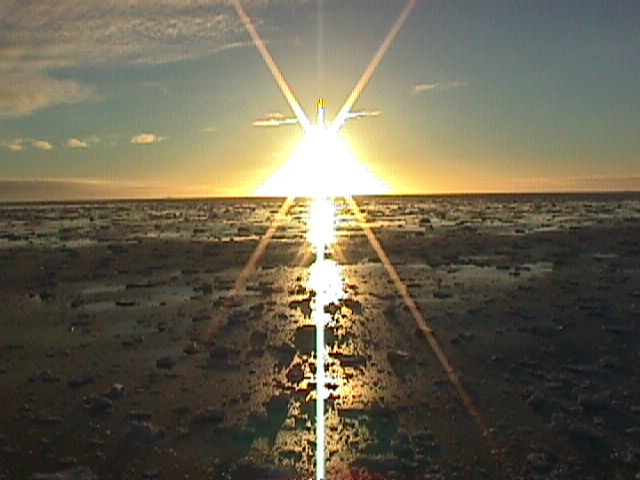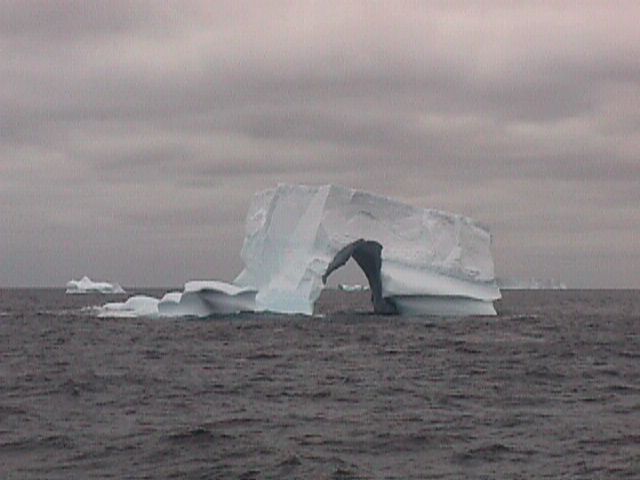| Date | Sunday 7th February 1999 |
| Time | 1200 (UTC-3) |
| Position | Latitude 75°25' South
Longitude 026°24' West |
| Next destination | Signy |
| ETA | 21st February 1999 |
| Total distance | 17440.6 Nautical Miles
(Since departing Grimsby on 17th October 1998) |
| Current weather | Glorious. In Antarctic words, Dingle! |
| Wind | Light |
| Sea state | Flat calm |
| Air temperature | -0.3°C |
| Sea temperature | -1.3°C |
Ship's
track - Updated every six hours from the weather observations sent
to Bracknell weather centre - direct from BAS
homepage.
Summary
Signy proved to be a flying visit with the ship arriving last Sunday morning and then departing in the early evening. All tasks were completed in record time, helped by the fact that there was not a great deal of cargo for the base.
Monday and Tuesday proved to be somewhat uncomfortable with the weather taking a turn for the worse and the ship was rolling heavily. No one knows why, but the periods of worst movement always occur at 1230 and 1830, which oddly enough coincides with the Officers meal times. I think one of the hardest jobs on board, especially during rough weather, is that of the cooks, who still have to slave over the hot stoves to keep us all well fed (actually it is very well fed as I myself have gained about 1 stone since departing the UK!), and what is more they always manage to do so with a smile.
On Wednesday 3rd February we started to come across a large number of ice-bergs, including the one shown below, but progress continued to be very good with nothing to hold us up in our trek south. The first pack-ice was not encountered until position 73°S 028°W, the same position reported to us by the RRS James Clark Ross (who had been doing some seismic survey work in the Weddell Sea).
Thursday night we had some snow and come Friday morning the decks and hatches were all white. A small, well dressed, in a red scarf and tie, snowman was spotted on the port bridge-wing! By lunchtime we had reached the Stancombe Wills glacier (where we stopped briefly on our first call to Halley in December) but this time we had no delays and soon after we were off N9 (an area of low shelf ice) where it is intended to load the heavy vehicles and cargo returning to the UK from the base. The problem with N9 is that it is some 50km from Halley, and so not ideal for general relief purposes due to the time taken to travel this extra distance. By 1500 we had reached Creek 3, where we discharged all the cargo in December. In the time since we had departed, all the sea ice had been broken off and it was now not going to be possible to use the same Creek as the ramp had also been partially destroyed.
As with all operations down here there was an alternative, in the shape of Creek 6, about 1km from Creek 3. This had a workable ramp with some 50m of sea-ice at the bottom, enough room for a snow-cat and sledge to get off the ramp and turn around. The only drawback now was that the actual headlands of ice-shelf were not wide enough to allow the Bransfield to come in and tie up alongside the sea-ice. Bransfield would have to stand off the ice-shelf and deploy the cargo tender 'Tula'. All cargo and passenger movements would be done this way. This meant that the whole operation would take longer than normal, but with the time allocated for the ships final call of the season this is not expected to be a great problem. All the cargo on board the Bransfield for the base was discharged on Saturday and today waste and outgoing cargo has been coming to the ship in a steady stream. One interesting thing being tried is that the ship is operating on UTC -3, whilst the base is three hours ahead of us on UTC! Timing can be interesting, but so far the system has worked very well indeed.
Sunday morning and a group of Killer Whales (Orcas) entered the area, swimming up to the sea-ice and affording some wonderful views of these majestic mammals. There were about six to eight in total and they calmly swam around the ship and the small bay where the sea-ice is for about 30 minutes. Then, just after lunch this afternoon, an even larger group of killer whales was sighted, swimming in a westerly direction some 1km from the ship. This group was estimated to be at least 15 in size, perhaps slightly more. Halley has always (well every time I have been down here) good for groups of whales to come by. Normally, once you see one group there will be others following later in the day. Up until this morning there had only been the occasional sighting of a lone Minke Whale on the way south from Signy. Fingers crossed we will see many more and hopefully get some photos on our digital camera. Alas, for both visits today the digital camera was not available!
To try and liven up this weeks page Jim Summers, of BAS HQ, who traveled
down to Halley with us from the Falklands has kindly written a few words
on the birds that he has seen......being a keen twitcher!
Seabirds between the Falklands and Halley Base: 28th January - 7th February by Jim Summers
The Bransfield sailed from Port Stanley at 7am Thursday January the 28th 1999.Immediately there were a great numbers of seabirds to be seen on the journey south from the Falklands. For me the large numbers of Great Shearwaters were the most impressive. During one year this species, together with Sooty Shearwater, makes one long migration throughout the north and south Atlantic Oceans. Theoretically you could see the same bird from the Falklands coast in January as from the Cornwall coast in September. I have never seen Great Shearwater around the Falklands in November and December as, I assume, it is still on it's southerly migration.
In the first two days out of Stanley there were also numerous Soft-plumaged Petrels, Black-browed Albatross, Southern Giant Petrels, Wilsons Storm-petrels together with lesser numbers of Sooty Shearwaters, White-chinned Petrels, Wandering and Grey-headed Albatross, Black-bellied Petrel and Prions (I guess the species was Broad-billed). I also saw one Grey-backed Storm-petrel on the first day. Soft-plumaged Petrel is another interesting species as it does not seem to have a clear idea about which direction it is heading in. It is constantly changing height and direction, turning back on itself and generally having fun.
By Saturday we had crossed most of the Drake's Passage and were nearing the South Orkney's. We started seeing the first Cape Pigeons (also known as Pintado Petrel) together with the occasional Snow and Blue Petrel. We no longer saw Great Shearwaters and Grey-headed Albatross as we were too far south and we saw only the occasional Soft-plumaged Petrel. A feature of the crossing between the Falklands and Signy was that the ship was normally surrounded by numerous seabirds of many different species. Only one Light-mantled Sooty Albatross was seen - quite a strange looking bird. Very pointed wings, diamond shaped tail and a prominent white eye.
We stopped at Signy Island for 9 hours on the Sunday the 31st. There were plenty of breeding Brown Skuas, Snow Petrels and Cape Pigeons. We also saw some Gentoo Penguins with chicks. I am not too sure how they survived as they nested on a beach that was popular with Elephant and Fur seals. Signy has plenty of other breeding species but we did not have time to visit them.
At Signy and further south the pure white form of the Giant Petrel became more numerous. These are often mistaken for Snow Petrels but are about 3 times larger with enormous beaks. The Snow Petrel is a much more delicate and fragile looking bird which is odd as it lives in the most bleak and cold environment. It is actually a tough bird.
South of Signy we entered the Weddell Sea and encountered the first icebergs. The weather turned colder and the strong south-westerly wind caused the ship to roll. The types and numbers of seabirds changed. Less numbers and less species. For the first day south of Signy fair numbers of Chinstrap Penguins could be seen. The numbers of Cape Pigeons increased to be big gangs following the ship. White-chinned Petrel became more numerous, as did Snow Petrel. The occasional Black-browed Albatross, Prion, Wilsons and Giant Petrel turned up to investigate the ship hoping for an easy meal. On Tuesday 2nd February the first Antarctic Petrels appeared. Like the Snow Petrels this species, for some reason, appears to prefer the most cold and hostile seas.
Further south just the occasional bird passed by. The selection was
limited to mainly petrel species - Snow, Wilsons, Pintado and Antarctic,
however on the evening of the 3rd a second Light-mantled Sooty Albatross
south of 68o South was a surprise to me.
Forthcoming Events
Continue loading cargo and waste from the base. Those personnel not remaining for the winter will also join the vessel in the next week or so. At present the intention is for the vessel to sail from Halley on 16th February, bound for Signy, Bird Island and then the Falkland Islands.
GM0HCQ/MM QRV 10122kHz @ 0000z
The next update will be written on Sunday 14th February 1999 and should
be published on Monday 15th February 1999.


Last updated 10/02/1999 - webmaster@dartcom.co.uk